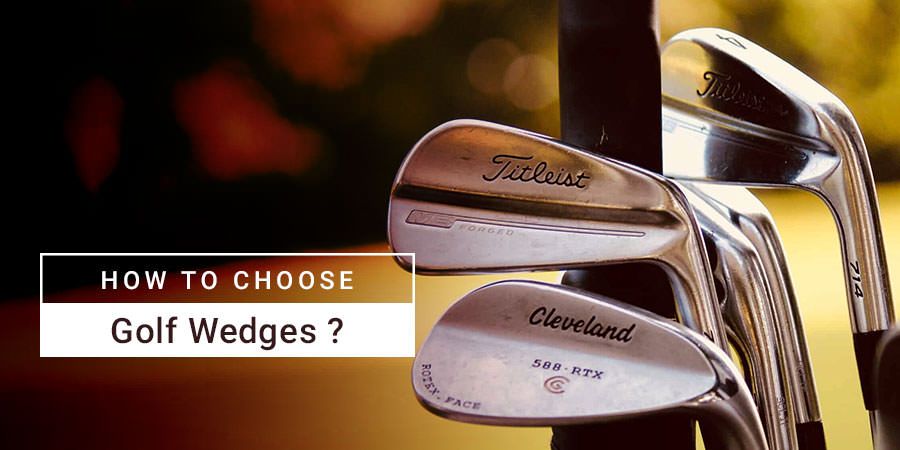GUIDE TO BUYING GOLF WEDGES – LOFTS, BOUNCE AND GRINDS EXPLAINED

Have you ever noticed in the bag of a PGA Tour golfer, they always carry between three and four wedges, and in some cases, even five wedges! The fact is, without proper bounce and loft combinations, you cannot become a master of the wedge game ever.
For example, Jordan Spieth has a very specific composition of wedges in his bag. As of the 2015 WGC HSBC Champions, Spieth is carrying the following wedges in his bag:-
| Loft | Bounce | Grind |
| 46 | 08 | F grind |
| 52 | 08 | F grind |
| 56 | 10 | S grind |
| 60 | 04 | L grind |
The Clearly visible thing here is, Spieth is one of those players with four wedges in the bag and with varying lofts, bounces, and grinds.
Once you understand and learn how to apply these three
elements buying a set of wedges won’t be quite as intimidating.
Loft

Let us start with the loft. For most players, this is going to be the only factor that you’ve ever considered when buying a wedge.
Somehow, well want to have that 64-degree wedge-like Phil Mickelson but never really understand that the gaps are more important than the lofts.
If we look at Spieth's collection, he's got gaps of 6 degrees, 4 degrees, and 4 degrees from the pitching wedge to the lob wedge.
The gap is the distinction in loft betwixt wedges. There are many choices for you when building your wedge set, but optimally, you will want to carry four wedges, which will allow you to cover your yardage gaps, and you can also play shots from several lies around the green.
There are just a few significant factors that you must consider when purchasing your wedges:
Don’t buy your wedges purely based on the loft (“bounce” matters too)
Bounce

The next crucial thing to be considered is bounce.
So what is bounce?
I'm going to try to describe it as quickly as possible.
Definition/Purpose of bounce– The amount of bounce describes how fast and how much the wedge repels off the playing surface when it comes into contact with it. This can be advantageous in situations where the turf/sand is fluffy because it prevents the club from digging deep into the surface and slowing the club down. It can also be disadvantageous if you are using a high bounce club on tight turf because the club will repel off the hard ground right into the middle of the golf ball.
How it Works (2 components)– Bounce is the distance that the leading edge of your club sits above the ground when the clubface is perfectly square to the target (see photo below)
But this measurement is only the beginning. The bounce on wedges also vary by the depth of the bounce or commonly known as Grind.
Combining the factors– Now that you understand what bounce is and the two components that determine the bounce, you must apply it.
To have a diverse range of wedges, you need not only different lofts but diverse bounces AND depth of bounces. Like we saw in Jordan’s set, he had bounces varying from 4 degrees (his lob wedge – 60) to 10 degrees (his sand wedge – 56).

Though there are hundreds of combinations that you could go with, I want to provide you with some guidelines for choosing the bounce on your wedges:
The sand wedge (54-56 degrees) - is expected to have the most and the deepest bounce.
The lob wedge (58-60 degrees) - have the smallest and the narrowest bounce.
The “gap” wedge (50-52 degrees) - is expected to have a low bounce and a medium depth.
The pitching wedge (46-48 degrees) - also have a low bounce and shallow to medium depth.
Overall, I believe that the sand wedge and the lob wedge are the most influential wedges to get the bounce right on because they will be used, most frequently around the greens.
At last, all I can say about bounce is that if you play on tight turf or at soft turf regularly, match your wedge bounces to these conditions.
If you play in an environment where the ground is always soft and lush, it may be wise to wear a sand wedge with 12 degrees of bounce and a lob wedge with 8 degrees of bounce.
Also, if you play somewhere where there are lots of hardpan and tight lies, you might carry a sand wedge with 10 degrees of bounce and a lob wedge of 4 degrees of bounce.
GRIND

Grinds are most specific with the Vokey wedges, and hence I would not miss a chance the explain those.
M Grind
If you're seeking a bit of versatility in your wedge, then the M Grind is for you. The M Grind works well on courses with average or firm turf conditions. Remember that the M Grind is geared towards those with a shallower angle of attack. Comes in 54, 56, 58, 60, and 62-degree loft options.
F Grind
The F Grind Vokey SM7 is for those who favor a classic design. Interestingly, the F Grind is the most famous option on the PGA Tour as well.
This one is well suited to both normal and soft turf conditions. And has a variety of loft options - ranging from 46 degrees up to 56 degrees.
S Grind
The S Grind Vokey SM7 is the popular middle-of-the-road alternative in the existing Titleist wedge lineup. You can choose from 54, 56, 58, and 60-degree options - all with 10 degrees of bounce.
D Grind
The D Grind Vokey SM7 is a fresh entrant to the Titleist wedge lineup.
This one is the right choice for better players often on courses with softer turf. The D Grind comes in 58 and 60-degree alternatives.
K Grind
The K Grind Vokey SM7 is the highest bounce choice in the Titleist Wedge queue. If you're a golfer who struggles from the bunkers, then the K Grind is for you.
It delivers the most forgiveness of any of the grinds,
which makes it a good option for a mid to high handicap golfer. Available with 58 or 60 degrees of loft.
L Grind
The L Grind Vokey SM7 is for golfers generally dealing with firm turf conditions. You know what that this is the lowest bounce from Titleist and are chosen by golfers who are invariably trying to create shots around the green. Available with 58 or 60 degrees of loft - both with just 4 degrees of loft.
Conclusion
Quite a lot has been covered in the above past. Do email in case of any doubts.
You can check the wedge collection on Golfoy by clicking here.






Please to comment on this post.